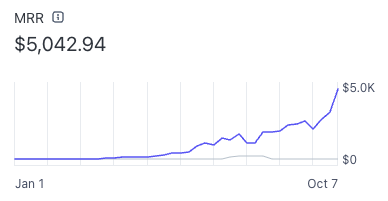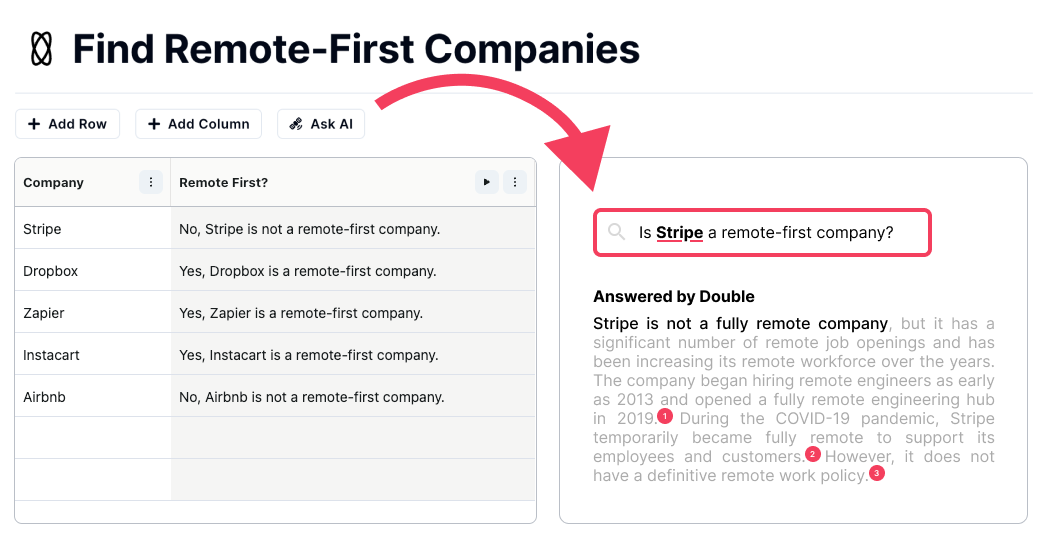Published April 24, 2024 by Gonzalo
This is the story of why we pivoted from usedouble.com, which was making $5k MRR only 6 months after launch and growing rapidly, to build double.bot from scratch.
Background
Wesley and I used to run a grocery delivery service in Toronto called Ninja Delivery. One of the worst parts about it was having to place inventory resupply orders almost every night, every vendor had a different website UI, some still communicated exclusively over emails. We have a background in engineering, but automating this task was hard due to the small amount of decision making involved across multiple steps (i.e We are out of diet coke, should we order this listing for a six pack of diet coke cans, or do we need diet coke bottles?) That is until OpenAI’s Davinci-003 was released. At that point, we decided to build a tool to automate the process. The MVP of this was a spreadsheet with Davinci-003 commands, this was the start of usedouble.com and we applied and got early into Y Combinator’s Winter 2023 batch with this idea.Getting the first users
We launched usedouble.com with a tweet and a hackernews comment. Back then any GPT-3 demo would go viral on Twitter and spreadsheets were somewhat of an untapped niche so getting early interest was easy. The product was simple, it let you feed information within your spreadsheet into GPT-3 and have the output organized in cells. Talking to our users led us to building a web scraper (people were unfamiliar with LLM hallucinations back then, and didn’t understand it lacked context from the web), so you could ask GPT-3 to find information from the web and put it in your spreadsheet. It may sound basic now, but at the time it enabled new workflows and attracted users to our product. Twitter and HackerNews engagement got us to 1,000+ users on our waitlist. From there on, our biggest growth drivers were Reddit posts, AI tools aggregators, and Youtube tutorials, in that order. On top of this, we also did a Product Hunt launch and scored top 5. A not so known fact is that when you place top 5, they amplify you the next day on their socials and newsletter, which drives a ton of traffic. Reddit was particularly great because once you have a few posts with a ton of traffic, you rank super high on SEO. And it’s evergreen, to this day it still brings us traffic despite us not putting any further effort.Niching down
At this point we were not monetizing and although we had a few people using it regularly, the product was very horizontal, it could do a lot of things but was not particularly well suited for anything in particular. So, naturally, the next step was to find out who is most willing to pay for it. At this time, our LLM costs also started creeping up, we brought up a paywall in March 2023, our OpenAI bill was: $7.18 in Dec 2022 $31.46 in Jan 2023 $512.86 in Feb 2023 So it was quickly getting out of hand. After more calls with users, it became clear that sales teams were the group most willing to pay us for our AI spreadsheet, so we started to build workflows and tools specifically for them. We shipped new features that let you import a list of leads onto usedouble.com, find and verify emails for them with 1 button, and enrich the leads with information from throughout the web using simple workflows that required only basic prompting. Later on we added webhooks to push and pull information from your CRM. The most popular tool on usedouble.com was the “Online AI instruction”, which takes your question, turns it into a Google Search query, searches Google, and reads the results, and uses that to provide an answer to your original question with citations. Later on, we built specific scrapers to be able to pull data from LinkedIn, Crunchbase, Google Maps, and other aggregators. You can think of it as Perplexity AI, but in bulk, as shown below.
Problems to be solved
There was interest for more data sources, and although you could keep adding every data aggregator to your app (similar to what Clay has done), one of the issues was the low differentiation and low pricing power of serving aggregators’ data. Everyone has access to the same data, so we could sell verified emails for 5 cents, but if we were to charge 10 cents then soon users would compare us to other services that charge a few mere cents less. A superior UX could get us some sort of pricing premium but not much. We also noticed that most users would import a list once, enrich it, and then not come back for months. This wasn’t always the case for bigger sales teams who had a constant need to churn through leads, but true for most of our users at the time. We were not solving an urgent, recurrent problem for these users. Another insight we uncovered was that most users actually need very simple enrichment (phone numbers, emails, Instagram handles, LinkedIn URLs), which are better served by traditional methods with which LLMs can’t compete economically. The people that want long tail enrichments are actually not that common (but they do exist and still use our old product to this day!).Experimenting with outbound campaigns
Once people brought their lists to usedouble.com and paid us to enrich them, their next usual step was to launch an outbound campaign. So we thought this would be a natural next step to deliver more value to our users, and keep them coming back. Once you have visibility over their outbound campaigns, you can also measure conversion rates and see exactly how much value you are providing, instead of selling leads at market rates. Our core hypothesis was that if we could do a better job at researching prospects at scale, we could then send more relevant emails which will convert better. Makes sense, right? We set out to prove this hypothesis with a handful of enterprise users who paid us to handle their outbound campaigns. For 2 months we ran custom enrichment flows, and then used the information to write personalized emails, all within our AI spreadsheet. At this time we were sending around 10,000 emails per week. Our personalized emails did not convert any better than using proven templates with a couple of custom fields, which was what these companies were already using, and their preference was to keep our enrichment service and pair it with their existing templates. We learned the hard way that for most products, it isn’t always possible to figure out whether a prospect has the specific problem they can solve based solely on public information. It is also cheap to just send an incremental email, with almost no penalty to having a low hit rate. So you can just send more emails whether or not they are the ideal target.Pivoting
After disproving our hypothesis, we took another look at our data enrichment product. Yes, it was growing but we questioned whether it was the biggest opportunity for us to pursue in the generative AI era. We started to experiment with other ideas (some which went viral and helped me build a following that was super fruitful down the line) and eventually settled on AI coding copilots. Throughout all of this time, we had been using AI to help us code faster, but some of our favorite tools like Github Copilot had not gotten any better. In fact, the most upvoted bugs from a year ago are still at the top of their list 2 years later, crazy! Some of my favorites include:- Disable co-pilot on import statements - 2 years+
- Doesn’t work well with multi-cursor mode - 2 years
- Accepted suggestions variables and functions are not auto importing - Getting close to 3 years
- Multi-cursor support is missing - Same as above
Takeaways
- Increasing prices is the easiest way of increasing MRR. We initially launched as a self-serve product with a free tier and plans starting at 20 dollars a month. Our growth accelerated when we switched to B2B / “talk to sales” starting at 500 dollars a month. The product didn’t change, but our growth trajectory did, and so did the quality of our users (our new higher paying users were more involved and willing to give more feedback).
- Don’t always listen to your users. Listening to users feedback and feature requests is a good idea, but I’d advise against shifting your entire value proposition based on users. This is what led us to exploring questions like “Can personalized emails lead to better outcomes?” which a sales expert might shut down immediately, but some of our users were not experienced sales professionals and neither were we, so we spent time learning the basics and experimenting with it.
- It is much easier to work on a problem that you personally have a deep understanding in. When we built usedouble.com, we knew nothing about sales. When we build double.bot, a lot of the time we are building for ourselves.
- On the topic of trusting your own judgement and taste, I thought this recent video from YC was excellent. In general I believe every founder eventually learns that they should trust their own judgement instead of consultants (PR, Branding, etc). Some learn this earlier than others.
- Incremental growth strategies are underrated. I am continuously surprised how many people still show up and use usedouble.com to this day, despite us not promoting it for months now. A lot of the posts and Youtube videos we uploaded many months ago never went viral, but drive steady traffic to this day by ranking on Google searches and topics people are interested in. We always seek virality but having a continuous stream of users who you can serve and retain is how you build a huge business.
- Maybe obvious but I had to learn this the hard way: ideally build something that people need to use on a regular basis. This will make your life much easier :)

